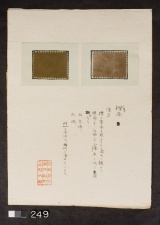Difference between revisions of "Kunugi (Oak) - left (249 L)"
Jump to navigation
Jump to search
(username removed) |
(username removed) |
||
| Line 5: | Line 5: | ||
| 249 | | 249 | ||
|- | |- | ||
| − | ! scope="row"| | + | ! scope="row"|Uemura number / title |
| − | | | + | | ; "Haze-some 25" |
|- | |- | ||
! scope="row"|Folder location | ! scope="row"|Folder location | ||
| Line 44: | Line 44: | ||
| - | | - | ||
|- | |- | ||
| − | ! scope="row"| | + | ! scope="row"|Uemura's notes |
| − | | The dyeing method is what was called "Tsurubami ( | + | | The dyeing method is what was called "Tsurubami ()" in the Ibukuyo () from the 8th century AD, Japan. |
|- | |- | ||
| − | ! scope="row"| | + | ! scope="row"|Uemura's date |
| Kyoto Murasakino | | Kyoto Murasakino | ||
|} | |} | ||
| − | [[Category: | + | [[Category:Uemura dye archive]] |
Revision as of 07:19, 24 July 2013
| Museum number | 249 |
|---|---|
| Uemura number / title | ; "Haze-some 25" |
| Folder location | 4th shelf |
| Sample location | left (249 L) |
| Fiber type | silk |
| Color | brown |
| Dyestuff (Japanese common name) | 櫟 : Kunugi |
| Dye (English common name) | Acorn |
| Dyestuff (botanical name) | Quercus acutissima Carruth. |
| Plant part | wood / dried (?) |
| Dyestuff extraction | boiled in water |
| Auxiliary agent in dye bath | - |
| Mordant | iron |
| Other auxiliary agent | - |
| Uemura's notes | The dyeing method is what was called "Tsurubami ()" in the Ibukuyo () from the 8th century AD, Japan. |
| Uemura's date | Kyoto Murasakino |
